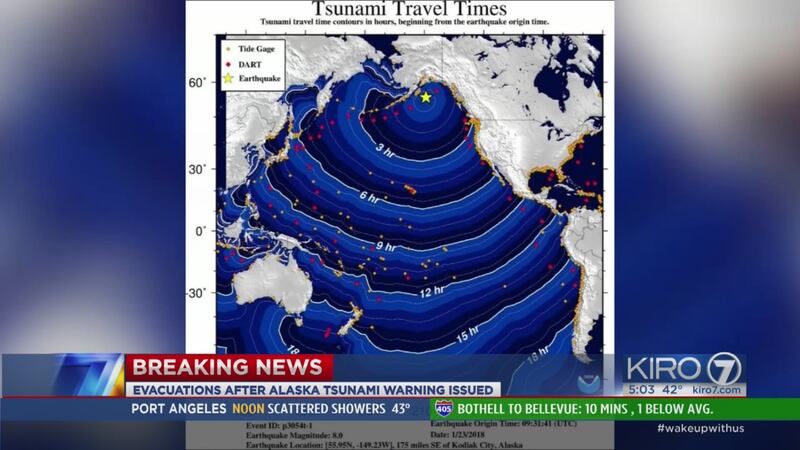A tsunami watch that was in effect for the entire West Coast after a M7.9 earthquake occurred off the south coast of Alaska was canceled by the National Weather Service Tuesday. A small tsunami was generated in Alaska.
Scroll down to continue reading.
Trending headlines
- M7.9 Alaska earthquake sparks tsunami scare for West Coast
- Man sues after propane torch engulfed him in flames
- Woman confronts crowbar-swinging burglar
- 'Huge increases' in Washington meth overdose deaths, say UW researchers
- Family holds on to hope after horrific crash
The cancellation came at 4:18 a.m. The alerts were canceled after more information and analysis allowed scientists to better define the threat.
The quake struck 175 miles southeast of Kodiak in the Gulf of Alaska. It was first recorded as a M8.2 at 1:30 a.m. but was downgraded to a M7.9.
There have been at least 10 aftershocks.
The watch also included coastal British Columbia and Hawaii, but was canceled as well.
Waves could still be high at the Washington coast. They were forecast to start at Neah Bay at 4:55 a.m., Westport at 5:05 a.m. and Port Angeles at 5:30 a.m.
>> Related: How to build a 7-day disaster emergency survival kit on a budget
Parts of south and southeast Alaska were under a tsunami warning, but the warnings were canceled. South Alaska and the Alaska peninsula were then reduced to an advisory, which has also since been canceled.
Overnight evacuations happened in Kodiak, Alaska. People awoke to tsunami sirens and warnings to get to higher elevations.
"This is not a drill. This is a tsunami warning. Everybody get at least 100 feet above sea level"<br/>
Larry LeDoux, superintendent of the Kodiak Island Borough School District, says schools were open as shelters and estimated there were about 500 people at the high school.
He said sirens go off in the community every week, as a test to make sure they are working.
People in Kodiak noted the water receding in their harbor about a foot.
Deep-ocean buoys had measured some waves cresting at around 32-feet as shock waves propagated across the Pacific Ocean.
Kodiak police posted these instructions to residents to their Facebook page.
The fire chief in Seward, a popular cruise ship port, says there was no panic. Seward fire chief Eddie Athey praised his community for doing "the right thing," calling it "a controlled evacuation" as people left for higher ground or drove along the only road out of the city.
Athey says the quake was gentle, and that it "felt like the washer was off balance." He says he knows of no damage in the community.
According to the United States Geological Service, the earthquake was the result of strike slip faulting where the Pacific plate is converging with the North American plate.
>> Related: State's largest quake drill ever to test readiness for ‘The Big One
USGS says over the last 100 years, 11 other earthquakes of magnitude 7 or larger have occurred within 600km of Tuesday's quake.
Meteorologist Nick Allard explains the science behind tsunamis in the video below.
The Associated Press contributed to this report.
Cox Media Group








